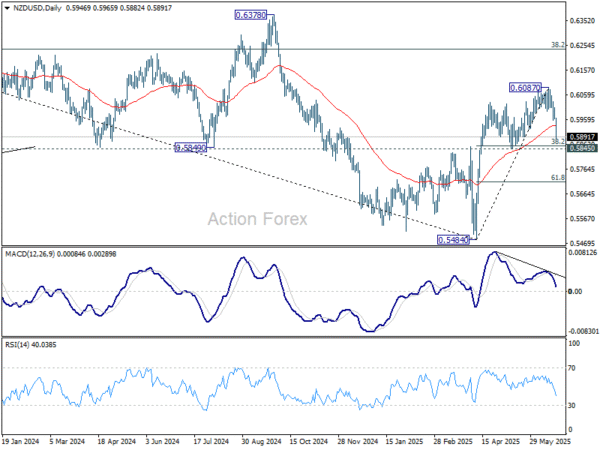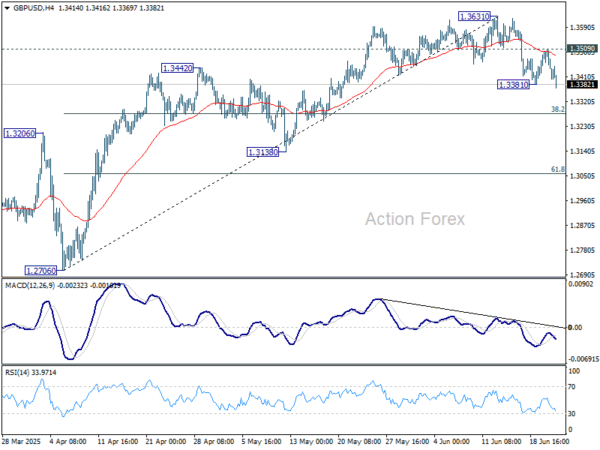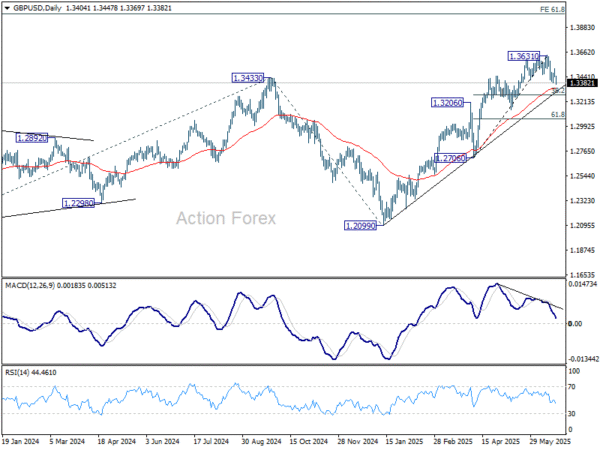Dollar continues to dominate currency markets as geopolitical anxiety keeps providing support. Safe haven demand, sparked by fears of escalating conflict between the US and Iran, has put economic data on the back burner. While Iran has reiterated threats of retaliation after the US bombing of its underground nuclear sites, it has yet to act in a meaningful way. That delay may be giving markets some breathing room, but tensions remain high—especially with reports that some vessels have already paused transit through the Strait of Hormuz.
Despite the elevated geopolitical backdrop, broader market reaction has been relatively restrained. European equity indexes are modestly in the red, and US futures are pointing to a flat open. Oil prices, which spiked sharply at the start of the week, have retraced most of those gains, while Gold continues to struggle for momentum despite the rise in geopolitical risk. Investors appear to be awaiting Iran’s next move before taking more directional bets.
In the currency markets, Dollar and Swiss Franc lead gains, joined by Euro. Commodity currencies are bearing the brunt of the risk-off tone, with Kiwi and Aussie sitting at the bottom of the daily performance chart. Yen has been softer despite the cautious mood, while Sterling and the Loonie are trading in the middle of the pack.
Technically, as NZD/USD’s fall from 0.6807 short term top accelerates, focus is now on 0.5845 cluster support (38.2% retracement of 0.5484 to 0.6087 at 0.5857). Strong bounce from the levels will retain near term bullishness for another rally through 0.6087 at a later stage. However, considering bearish divergence condition in D EMA, sustained break of 0.5845/57 will raise the chance of near term bearish reversal, and target 61.8% retracement at 0.5714 next.
In Europe, at the time of writing, FTSE is down -0.22%. DAX is down -0.56%. CAC is down -0.75%. UK 10-year yield is down -0.039 at 4.505. Germany 10-year yield is down -0.017 at 2.503. Earlier in Asia, Nikkei fell -0.13%. Hong Kong HSI rose 0.67%. China Shangi SSE rose 0.65%. Singapore Strait Times fell -0.11%. Japan 10-year JGB yield rose 0.0087 to 1.411.
UK PMI composite rises to 50.7, weak growth and softening inflation
The UK economy showed marginal improvement in June, with PMI Composite inching from 50.3 up to 50.7, suggesting the economy is narrowly expanding. PMI Services rose from 50.9 to 51.3, while Manufacturing remained below the 50 threshold, albeit improving from 46.4 to 47.7.
S&P Global’s Chris Williamson described the picture as one of “lackluster” activity, with data pointing to just 0.1% GDP growth in Q2. Beyond weak growth, the survey flagged ongoing uncertainty from recent UK policy shifts, global trade frictions, and geopolitical instability, including increased Middle East tensions.
Crucially, inflationary pressures have cooled significantly because of the above developments. With growth near stall speed and inflation slowing, the path is opening for BoE to deliver another rate cut in August.
Eurozone PMI composite unchanged at 50.2, inflation risk contained for ECB
Eurozone flash PMIs offered little cause for celebration in June, as the economy continued to tread water. PMI Composite held steady at 50.2. PMI Manufacturing was unchanged in contraction at 49.4. Services ticked back from 49.7 to the 50.0 mark, barely returning to expansion.
According to Hamburg Commercial Bank’s Cyrus de la Rubia, the bloc is “struggling to gain momentum,” with both manufacturing and services showing only marginal progress. Germany showed faint signs of improvement, but France continues to act as a drag. Still, firms remain cautiously optimistic: employment has been broadly stable, and expectations have improved modestly according to the survey.
For ECB, while services inflation remains “slightly tense” due to sticky input costs, this is counterbalanced by disinflation in goods and the dampening effects of a strong Euro and US tariffs. Energy prices—now rebounding due to Middle East tensions—could become a concern, though much of the impact is not yet captured in the current PMI readings.
Japan PMI composite rises to 51.4, but trade uncertainty weighs on demand
Japan’s private sector showed a modest rebound in June, with PMI Composite rising from 50.2 to 51.4, the highest reading since February. The pickup was led by stronger services sector, which rose from 51.0 to 51.5. PMI Manufacturing returned to expansion territory at 50.4, up from 49.4.
Annabel Fiddes of S&P Global noted that business activity gained momentum into quarter-end, but demand conditions remained fragile. New business rose only slightly, while foreign demand for manufactured goods weakened further. Firms cited ongoing concerns over US tariffs and global trade uncertainty, which continued to weigh on client orders and export sales.
Still, there were signs of easing cost pressures, with input prices rising at the slowest pace in 15 months. Employment also improved, with overall job creation accelerating to the fastest rate in nearly a year.
Australia PMIs improve modestly, support case for further RBA cuts
Australia’s private sector showed modest improvement in June, with the S&P Global PMI Composite rising from 50.5 to 51.2. PMI Services climbed from 50.6 to 51.3, while PMI manufacturing held steady at 51.0.
According to S&P Global’s Jingyi Pan, forward-looking indicators present a mixed picture. While output expectations remain positive, divergences between sectors were notable. New orders and future output softened more clearly in manufacturing, while services continued to gain traction. Weak external demand remains a concern, with export orders seeing their sharpest drop in nearly a year.
Combined with signs of easing inflation and slower employment growth, the PMI report supports the case for further rate cuts by RBA in the second half of 2025.
GBP/USD Mid-Day Outlook
Daily Pivots: (S1) 1.3422; (P) 1.3467; (R1) 1.3492; More…
GBP/USD’s fall from 1.3631 short term top resume by breaking 1.3381 temporary low. Intraday bias is back on the downside for 38.2% retracement of 1.2076 to 1.3631 at 1.3278. Strong support should be seen there to bring rebound. Break of 1.3509 resistance will turn bias back to the upside for retesting 1.3631 high. However, decisive break of 1.3278 will suggests that larger scale correction is underway and target 1.3206 resistance turned support and below.
In the bigger picture, up trend from 1.3051 (2022 low) is in progress. Next medium term target is 61.8% projection of 1.0351 to 1.3433 from 1.2099 at 1.4004. Outlook will now stay bullish as long as 55 W EMA (now at 1.2948) holds, even in case of deep pullback.
















